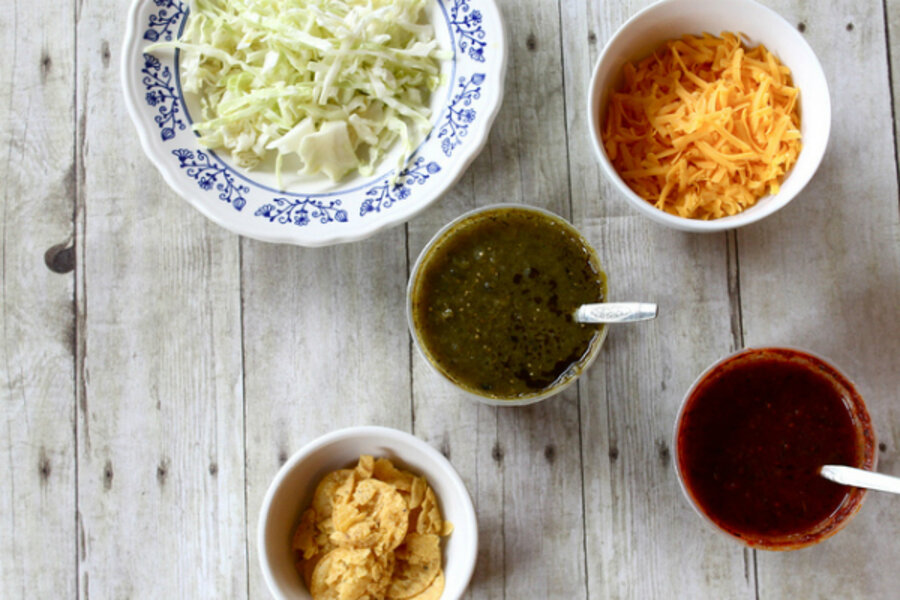Cooking a pot of beans
Loading...
Recently I sat in my spiritual director's office and cried for an hour.
I told her I'd been wanting to cry about the devastation in Oklahoma, and then the I-5 bridge in Washington collapsed. Yancey and I both cross that bridge several times a week, and we'd been on it the day before.
I won't be scared to cross bridges in the future or scared to drive. But I am thinking about the fragility and unpredictability of life. I'm thinking about the illusion of control I love to nurture and how much comfort I take in my plans.
And then I hear Jack Kornfield saying:
"The unawakened mind tends to make war against the way things are."
Things are messy, unclear, unfair. They're unpredictable and often beautiful. Things are sad, violent, and hard. They're also heartbreakingly tender and full of possibility. And the challenge for all of us (especially for my orderly self) is to accept what is. Our home has not been devastated by a tornado, but our commutes to work south of us may be increased by several hours a day for a year until the bridge gets fixed. My spiritual director said, "What if you think of the bridge collapse as the collapse of your ideas about God and yourself that aren't working for you anymore?"
I've found I haven't had bandwidth this week for much beyond daily tasks and feeling sad. I haven't felt motivated to blow through my to-do list or start anything new. Instinctively, I knew this week was a "pot of beans" week. When I dumped the pinto beans into a bowl to soak, just the sound of them falling out of the jar was comforting. I know exactly what to do with them, I know my family will be nourished for days, and I know we'll be able to devote our energies to things other than cooking for awhile.
If you've been reading this blog for any length of time, you know my attachment to dried beans. I'm a huge fan and seem to have endless energy for cooking them and advocating for them. I always come across folks who need an introduction, though. They've never cooked them before and are unsure how those hard little legumes become soft and flavorful. So I thought I'd stop saying, "Oh, just soak 'em and boil 'em" and give a little more instruction. (I love you "measure-twice-cut-once" folks. I'm not one of you.)
The most common way my family eats beans is pinto beans over rice (or roasted potatoes or corn bread) with condiments – shredded cheese and cabbage, salsa, finely chopped onions and peppers, chopped kale, hot sauce, crushed tortilla chips, sometimes a fried egg. I set all the condiments in the middle of the table, and we each do it our own way. Wyatt mixes his rice and beans together, then adds salsa and sometimes cheese. Loretta keeps her rice and beans separate and puts hoisin sauce on her rice. Yancey and I take a lot of vegetables and keep the whole bowl layered. And we'll eat this for several nights in a row until the beans are gone. My kids have never tired of it.
Pot of Beans
This "recipe" is from Mark Bittman. Since I've never followed any instructions for cooking beans, I didn't trust myself to describe it properly! He gives lots of options for soaking or not soaking, which is the biggest question people seem to have. The reason for soaking is simply to decrease the cooking time. I do it when I've thought ahead. When I haven't thought ahead, I don't soak. Some people say it decreases the flatulence factor of beans, though I can't say I've found that to be true. If your tummy has trouble with beans, there are at least three remedies. The first is, don't undercook your beans! They won't taste good and they'll be hard for your body to digest. The second is to eat beans more often. Your body will get used to digesting them. And the third is to take an enzyme like Beano.
If you buy your beans in bulk at a co-op or other place where they have high turnover in their dry goods, they will be fresher and will cook more quickly. If you buy them in prepackaged and labeled bags at the grocery store, they will likely be older and take longer to cook. They don't go bad or taste worse – they are just more hard.
1 pound dried beans, washed and picked over (any kind but lentils, split peas, or peeled and split beans)
Water, salt, and pepper
Soaking: You can soak your beans overnight if you think of it. Or "quick soak" them by putting the beans in a large pot and covering them with a couple inches of cold water. Bring the beans to a boil and boil for 2 minutes. Cover the pot with a tight-fitting lid and let them soak for 1-2 hours. Or you can not soak them at all. They'll take a bit longer to cook.
Cooking. If you've soaked your beans, drain them, and cover again with 2 inches of cold water. Bring the pot to a boil, then adjust the heat so the beans bubble gently. Partially cover and cook, stirring every now and then, checking the beans for doneness every 20 minutes or so, and adding more water as necessary. Small beans might take as little as 30 minutes and older, larger beans up to 90 minutes.
Seasoning. Add salt and pepper when the beans are just turning tender. Stop cooking when the beans are done the way you like them and taste and adjust the seasoning.
Storing. Here you have a few options. Drain the beans (reserving the liquid separately) to use them as ingredients or salads or other dishes where they need to be dry. Or finish them with one of the ideas below. Or store the beans as is and use with or without the liquid as needed. They will keep in the fridge for days and in the freezer for months.
Adding Flavor. You can add a bay leaf, peppercorns, thyme sprigs, parsley leaves and stems, chili powder, or other herbs and spices. You can sauté chopped onion, carrot, celery or garlic until soft and fragrant and add them in. Or cook your beans with a ham hock, pork chop, beef bone, or sausage. Fish it out after cooking, chop up the meat, and stir it back into the beans.








